Denver 2011
(and India)
I attended the Denver show
for the first time, both as a buyer and a seller. There wasn't much truly
new material of significance, but when that occurs, one
just has to look harder for interesting older material. I have also
included a number of Indian specimens from my recent trips.
My next updates will include
new finds from Bolivia and China's Inner Mongolia Autonomous Region that were
partially sourced in Denver, but mostly through contacts in those countries.
|
DV01
Tourmaline var. Elbaite
Malkhan
pegmatite field, Krasnyi Chikoy, Chitinskaya Oblast', Transbaikalia,
Eastern-Siberian Region, Russia
7.6x
3.0x 3.0 cm
$2000
A
fairly large and well terminated polychrome tourmaline from the Malchan
pegmatite field in Eastern Siberia.
This
crystal grades from an orangish red, to yellowish green, to a darker
brown green near the base. There is no damage; all the edges are
sharp and the faces intact.
Typically
I have shied away from these as the prices asked by the Russian dealers
usually start right about (or above) where I have priced this one.
The
Malchan deposit is actually a fairly recent discovery, having been
discovered southeast of Lake Baikal (near the Mongolian border) in
1980. The locality has been producing in small amounts since,
though on a scale far smaller than either the Brazilian or Afghan
tourmaline deposits. I will also add that the "warmer"
colored tourmalines (reds, yellows, oranges) are known from fewer
deposits than the greens and blues (which account for the bulk of the
Afghan/Brazilian production.) To my knowlege the main producers of these
colors are currently Malchan (where this one is from), and the various
pegmatites in Madagascar and Nigeria.
This
piece really lights up when backlit correctly.
|
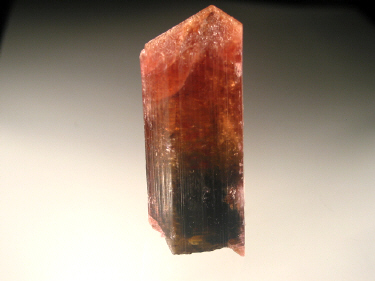 |
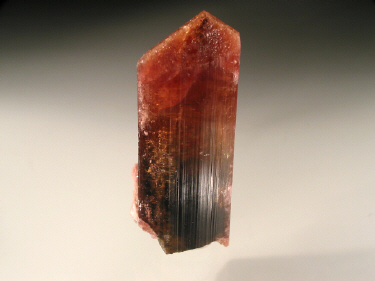 |
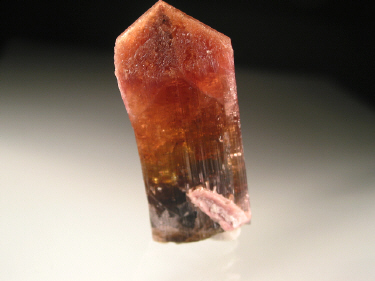 |
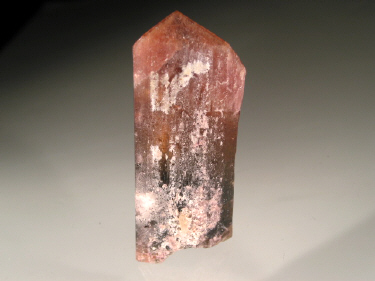 |
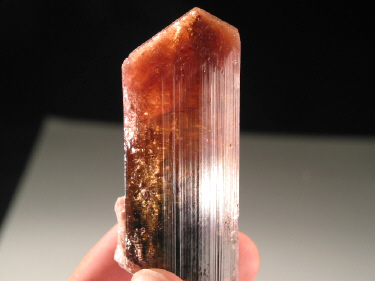 |
|

DV02
Aquamarine with Topaz
Sherlovaya
Gora, Adun-Cholon Range, Nerchinsk Gem mines, Nerchinsk, Chitinskaya
Oblast', Transbaikalia, Eastern-Siberian Region, Russia
6.0x
4.3x 3.8 cm
$1500
Despite
the fact that this location has been producing gem material
intermittently since 1723, specimens remain exceedingly rare. This
was by far the best of approximately 5 specimens from a small pocket
that were shown at this year's Denver show.
The
aquamarine crystal itself has no visible point of attachment. I
hesitate to call it double terminated however, because the bottom is
lightly etched. The crystal has a good aqua color with slight
hints of green, and very good translucency. Under the proper
lighting, the color really jumps out and it can be fully appreciated.
The
aquamarines have been overgrown by hundreds of terminated, colorless
topaz crystals. All in all it is a very beautiful combination
specimen from a classic Russian locality, certainly the type of material
that is not often seen.
|
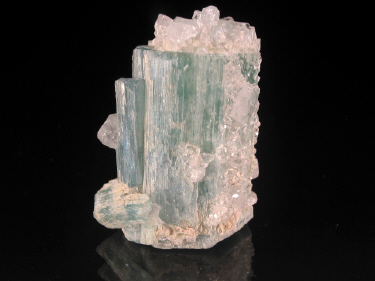 |
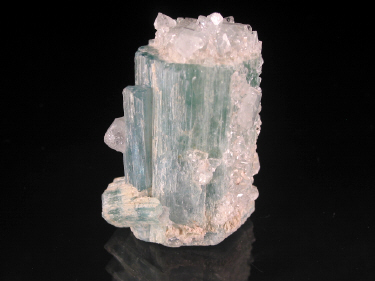 |
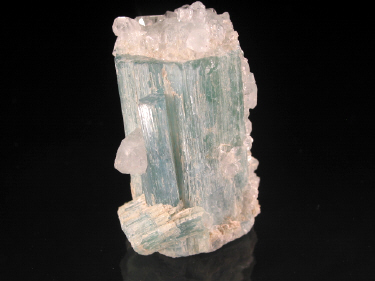 |
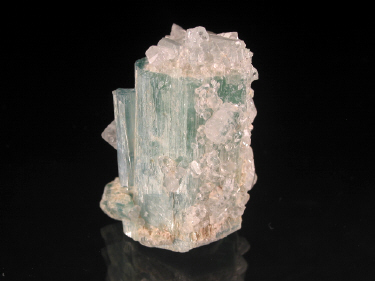 |
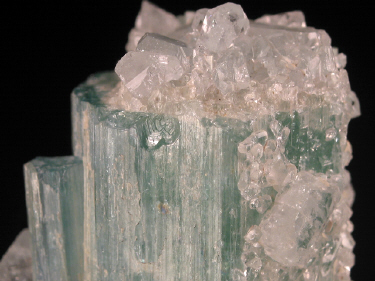 |
|
DV03
Apophyllite-(KF)
Ahmadnagar,
Maharashtra Prov., India
11.8x
11.4x 7.2 cm
$850
A
large cabinet specimen with a starburst of green apophyllite nicely
centered on a white, heulandite coated matrix. A couple years ago
this would have been called "fluorapophyllite," but the IMA
changed the nomenclature.
Despite
the fact that these have been coming out for some time, these remain
among the most desirable of Indian minerals. They are not as rare
as the red fluorites, but the bright greens make them stand out among
the masses of generally pastel colored zeolites.
The
green color is caused by vanadium inclusions on the order of parts per
million. A difference of a few ppm has a substantial effect on the
color of the apophyllite-(KF), and accounts for the difference in
intensity of the greens from the various locations.
Please
note that the last 6 mm of the crystal have been reattached. Apart
from the fact that is not noticable, I personally think this is
insignificant given that all of the other crystals are perfect, and that
it is only a 6 mm section.... still, I realize that this may be
off-putting to some people, so i have marked it at approximately 1/3 of
what I would consider to be the reasonable value, had that not been the
case... and even with that issue it's still a bargain.
|
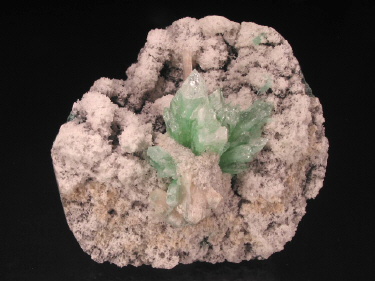 |
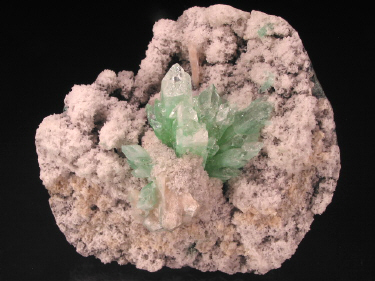 |
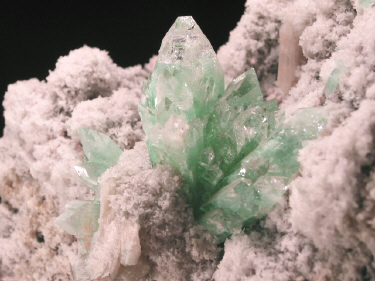 |
|
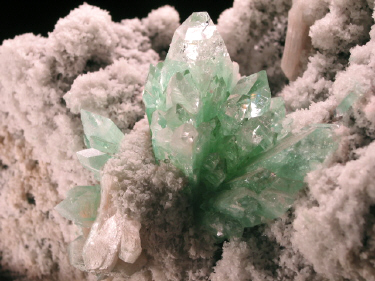
|
|
DV04
Okenite,
Gyrollite, Calcite
Kandivali,
Mumbai Area, Maharashtra Prov., India
20.0x
16.5x 11.0 cm
$650
Yes,
I am posting an okenite geode. These have become fairly common
over the last 10 years, and are perhaps one of the most iconic of Indian
zeolites. Actually, these is a very simple reason for this: the
Kandivali quarry is located in the greater Mumbai area, and with the
economic boom of the last several years, the quarry's proximity to the
growing metropolis made it one of the busiest as the demand for
roadfill grew. With more quarrying came more specimens, but then
the city grew to include the quarry. These days, it is not
uncommon to see taxies with "KANDIVALI" painted on the rear
window.
Of
course, that meant that the value of the land the quarry was situated on
increased, so as has
happened at so many other locations around the world, developers
bought the quarry, and now there will be no more of these okenites, or the
prehnite pseudomorphs, babingtonites, etc.
This
is a great example of this material, a large cabinet specimen consisting
of a geode filled with cotton ball-like clusters of acicular okenite and
small gyrolite orbs.
|
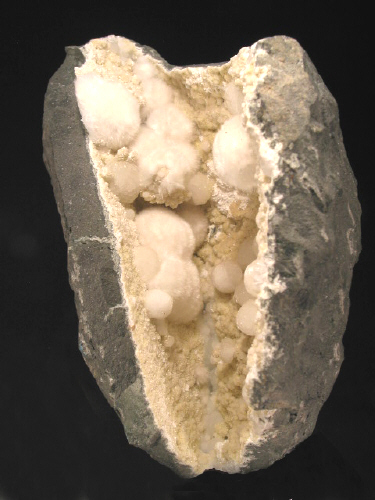 |
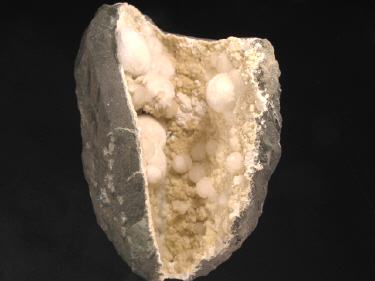 |
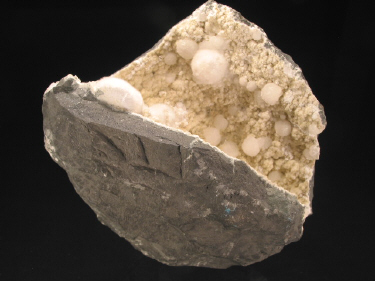 |
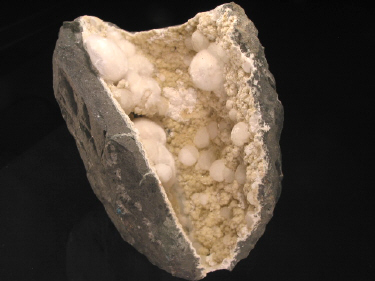 |
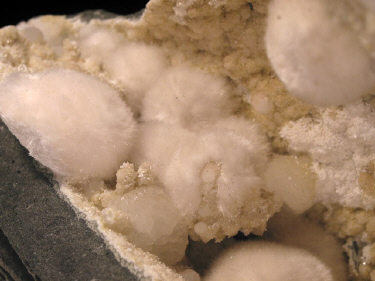 |
|
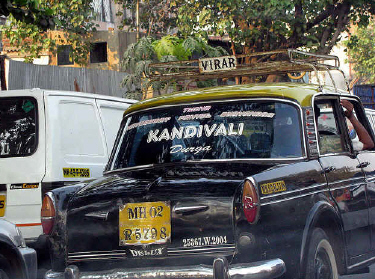
Photo Credit: Jaya Ramachandani |
|
DV05
Okenite, Gyrollite, Calcite
Kandivali,
Mumbai Area, Maharashtra Prov., India
13.0x
11.5x 14.3 cm
$650
Ex.
Freilich (dealer stock)
A
large calcite crystal on a prehnite coated matrix. On most
specimens that I have seen from this location, the calcite is just an
accessory to the prehnite, where it occurs as small crystals (sub 1 cm)
scattered around the prehnite stalactites.
That
is clearly not the case with this specimen, and actually, this is the largest calcite I have
seen form this location. It is positioned dramatically on its
matrix, and you can see the interesting step-like growth patterns on the
right side of the crystal.
The
left edge has a couple blemishes, but the piece is exactly as you see in
the pictures.
All
in all, it is a dramatic cabinet specimen from a now defunct locality
(see explanation in the previous specimen's description)
|
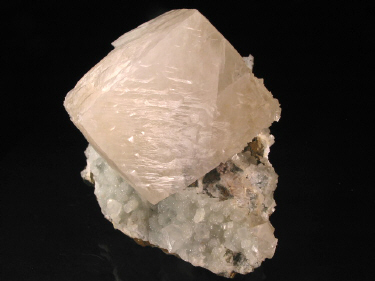 |
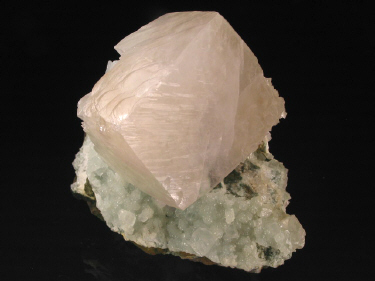 |
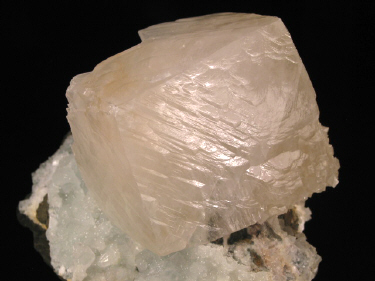 |
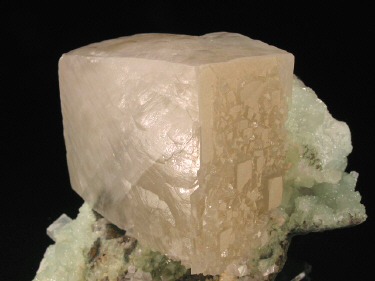 |
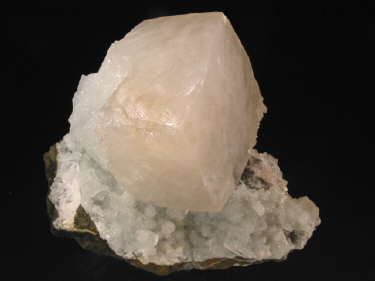 |
|
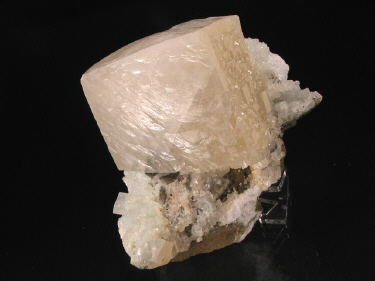
|

DV06
Fluorite
on Calcite
Shangbao
Mine, Leiyang Co., Hengyang Pref., Hunan Prov., China
6.5x
3.8x 3.5 cm
$650
Fluorite
has become iconic of the Chinese mineral bonanza, yet specimens from the
Shangbao mine possess a beauty and refinement not often seen in the much
larger masses or plates from the various other fluorite localities. As a
result, they are among the most collectible and sought after
This
specimen is a perfect example of why this is the case. There is
absolutely no damage to the piece, which has multiple purple fluorites
with beveled edges and light phantoms perched on a terminated calcite
crystal.
Multiple
Chinese dealers have told me over the past several months that the
Shangbao Mine has closed, meaning that pieces like this will gradually
become more and more scarce. Even ignoring that however, this
remains an exceptional little miniature.
|
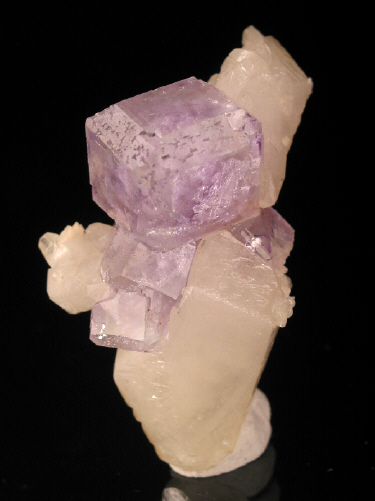 |
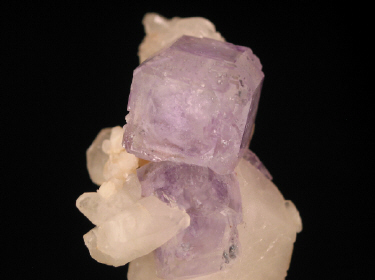 |
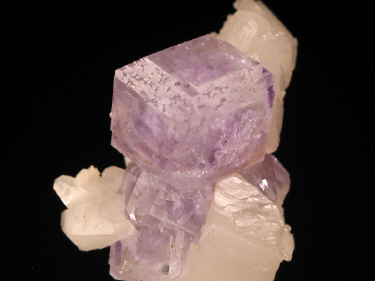 |
|
DV07
Tourmaline var. Elbaite
Malkhan
pegmatite field, Krasnyi Chikoy, Chitinskaya Oblast', Transbaikalia,
Eastern-Siberian Region, Russia
3.6x
1.4x 1.2 cm
$350
A
red, well terminated tourmaline from the Malchan pegmatite field in
Eastern Siberia. There is no damage; all the edges are sharp and the
faces intact.
The
Malchan deposit is actually a fairly recent discovery, having been
discovered southeast of Lake Baikal (near the Mongolian border) in
1980. The locality has been producing in small amounts since,
though on a scale far smaller than either the Brazilian or Afghan
tourmaline deposits. I will also add that the "warmer"
colored tourmalines (reds, yellows, oranges) are known from fewer
deposits than the greens and blues (which account for the bulk of the
Afghan/Brazilian production.) To my knowlege the main producers of these
colors are currently Malchan (where this one is from), and the various
pegmatites in Madagascar and Nigeria.
|
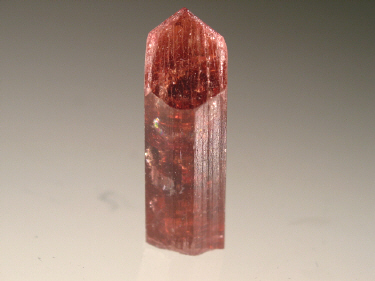 |
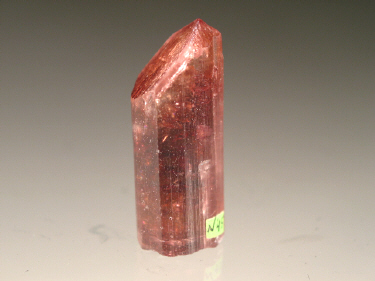 |
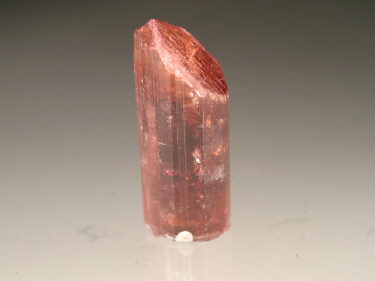 |
|
DV08
Tourmaline var. Elbaite
Malkhan
pegmatite field, Krasnyi Chikoy, Chitinskaya Oblast', Transbaikalia,
Eastern-Siberian Region, Russia
3.8x
1.3x 1.1 cm
$350
A
pueplish-red, well terminated tourmaline from the Malchan pegmatite
field in Eastern Siberia. There is no damage; all the edges are sharp
and the faces intact.
The
Malchan deposit is actually a fairly recent discovery, having been
discovered southeast of Lake Baikal (near the Mongolian border) in
1980. The locality has been producing in small amounts since,
though on a scale far smaller than either the Brazilian or Afghan
tourmaline deposits. I will also add that the "warmer"
colored tourmalines (reds, yellows, oranges) are known from fewer
deposits than the greens and blues (which account for the bulk of the
Afghan/Brazilian production.) To my knowledge the main producers of
these colors are currently Malchan (where this one is from), and the
various pegmatites in Madagascar and Nigeria. The famous Jonas
Mine in Brazil has alos produced similar colors.
|
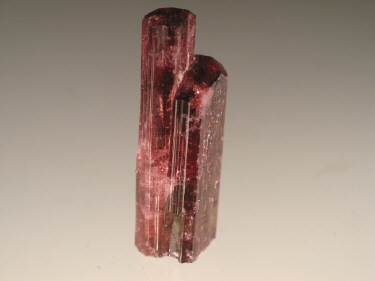 |
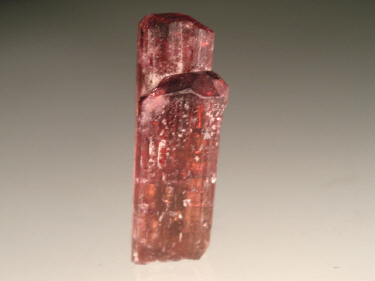 |
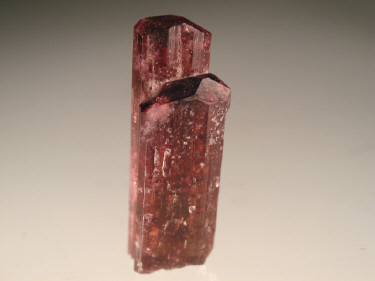 |
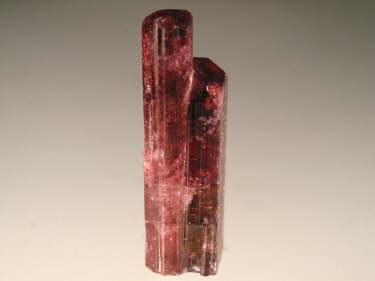 |
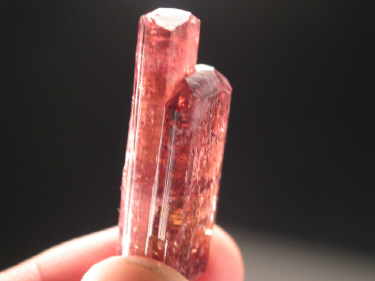 |
|
DV09
Tourmaline var. Elbaite
Malkhan
pegmatite field, Krasnyi Chikoy, Chitinskaya Oblast', Transbaikalia,
Eastern-Siberian Region, Russia
3.1x
1.5x 1.5 cm
$290
A
well terminated polychrome tourmaline from the Malchan pegmatite field
in Eastern Siberia. There is no damage; all the edges are sharp and the
faces intact. The color grades from a maroon red at the base, to a
yellowish orange near the top.
The
Malchan deposit is actually a fairly recent discovery, having been
discovered southeast of Lake Baikal (near the Mongolian border) in
1980. The locality has been producing in small amounts since,
though on a scale far smaller than either the Brazilian or Afghan
tourmaline deposits. I will also add that the "warmer"
colored tourmalines (reds, yellows, oranges) are known from fewer
deposits than the greens and blues (which account for the bulk of the
Afghan/Brazilian production.) To my knowlege the main producers of these
colors are currently Malchan (where this one is from), and the various
pegmatites in Madagascar and Nigeria.
|
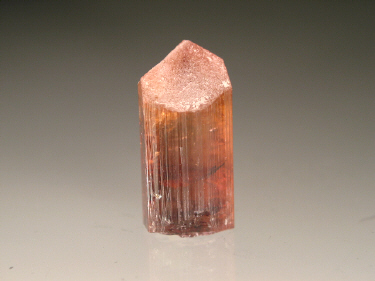 |
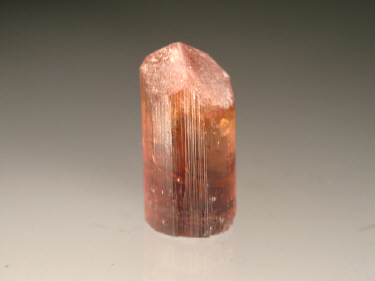 |
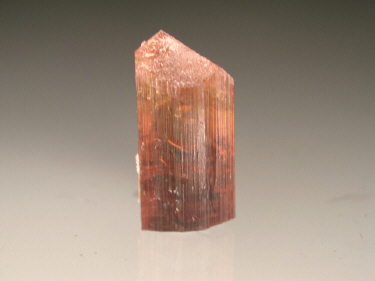 |
|
DV10
Tourmaline var. Elbaite
Malkhan
pegmatite field, Krasnyi Chikoy, Chitinskaya Oblast', Transbaikalia,
Eastern-Siberian Region, Russia
3.2x
1.2x 1.0 cm
$250
A
brownish red, terminated tourmaline from the Malchan pegmatite field in
Eastern Siberia. There is no damage; all the edges are sharp and the
faces intact.
The
Malchan deposit is actually a fairly recent discovery, having been
discovered southeast of Lake Baikal (near the Mongolian border) in
1980. The locality has been producing in small amounts since,
though on a scale far smaller than either the Brazilian or Afghan
tourmaline deposits. I will also add that the "warmer"
colored tourmalines (reds, yellows, oranges) are known from fewer
deposits than the greens and blues (which account for the bulk of the
Afghan/Brazilian production.) To my knowledge the main producers of
these colors are currently Malchan (where this one is from), and the
various pegmatites in Madagascar and Nigeria. The famous Jonas
Mine in Brazil has alos produced similar colors.
|
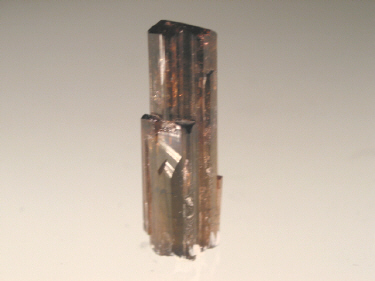 |
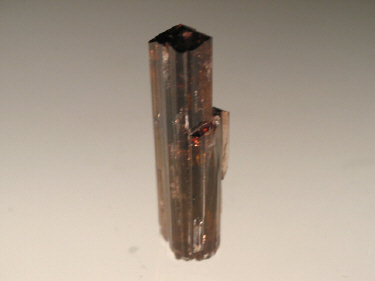 |
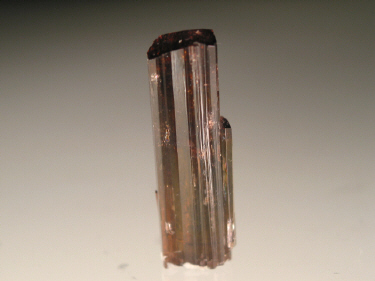 |
|
DV11
Tourmaline var. Elbaite
Malkhan
pegmatite field, Krasnyi Chikoy, Chitinskaya Oblast', Transbaikalia,
Eastern-Siberian Region, Russia
3.6x
1.6x 1.6 cm
$335
A
pueplish-red, well terminated tourmaline from the Malchan pegmatite
field in Eastern Siberia. There is no damage; all the edges are sharp
and the faces intact.
The
Malchan deposit is actually a fairly recent discovery, having been
discovered southeast of Lake Baikal (near the Mongolian border) in
1980. The locality has been producing in small amounts since,
though on a scale far smaller than either the Brazilian or Afghan
tourmaline deposits. I will also add that the "warmer"
colored tourmalines (reds, yellows, oranges) are known from fewer
deposits than the greens and blues (which account for the bulk of the
Afghan/Brazilian production.) To my knowledge the main producers of
these colors are currently Malchan (where this one is from), and the
various pegmatites in Madagascar and Nigeria. The famous Jonas
Mine in Brazil has alos produced similar colors.
|
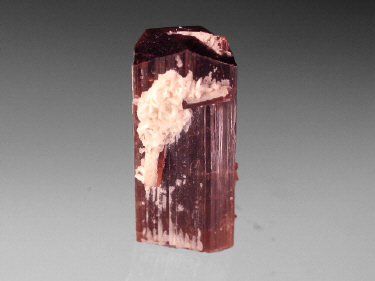 |
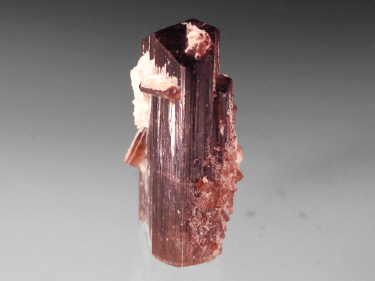 |
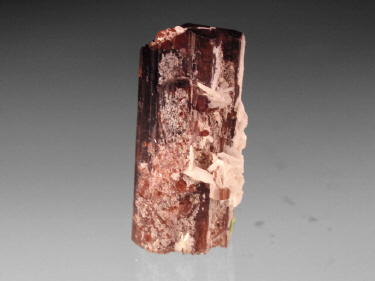 |
|
DV12
Fluorite on Quartz
Mahodari
Quarry, Nasik Area, Maharashtra Prov., India
11.5x
8.0x 2.6 cm
$470
A
yellow fluorite hemisphere on a quartz matrix, The piece is
entirely damage free.
The
small black dot on the lowe right side of the speimen is a julgoldite
crystal.
These
odd fluorites are the result of very rapid cooling, and are known mainly
from two Indian locations: the Mahodari Quarry in Nasik (Maharashtra
Prov.) and a second location a few hundred km to the northeast in Madhya
Pradesh. Specimens from the second locality tend to be almost
stalactitic in appearance, and are often found on dark amethyst.
Unfortunately, they are also often scratched up, as if someone were
trying to remove an unsightly coating.
|
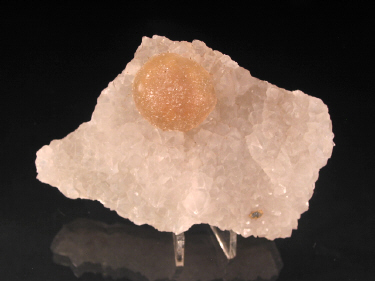 |
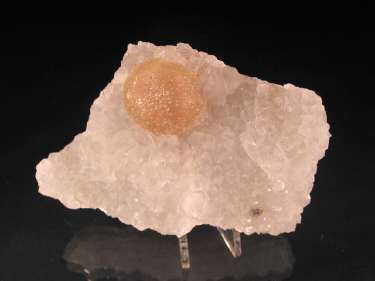 |
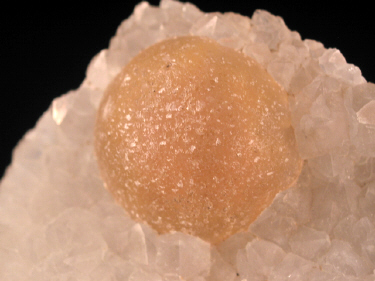 |
|

DV13
Apophyllite-(KF)
Nasik
Area, Maharashtra Prov., India
9.1x
7.4x 4.5 cm
$230
A
cabinet specimen hosting a linear cluster of green apophyllites on
matrix. A couple years ago this would have been called "fluorapophyllite,"
but the IMA changed the nomenclature.
Despite
the fact that these have been coming out for some time, these remain
among the most desirable of Indian minerals. They are not as rare
as the red fluorites, but the bright greens make them stand out among
the masses of generally pastel colored zeolites.
The
green color is caused by vanadium inclusions on the order of parts per
million. A difference of a few ppm has a substantial effect on the
color of the apophyllite-(KF), and accounts for the difference in
intensity of the greens from the various locations.
It
is also interesting to note that the shape of the crystals is also often
indicative of their origins. Crystals with flat terminations (like
these) typically originate around Nasik, the lightly colored pointed
examples are usually found around Jalgaon, and the more intensely
colored crystals with pointed terminations have typically come from the area
around Poona.
|
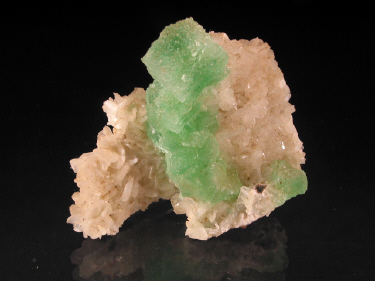 |
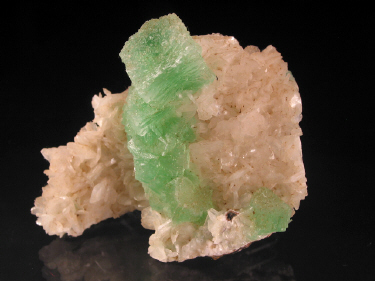 |
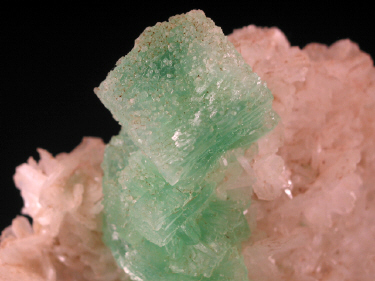 |
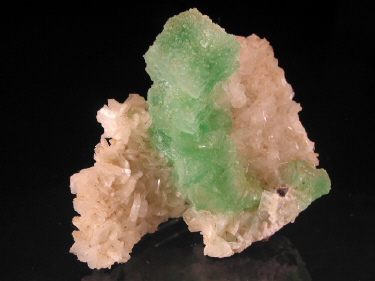 |
|
DV14
Calcite, Apophyllite, Laumontite, Heulandite, Stilbite
Nasik
Area, Maharashtra Prov., India
12.1x
6.8x 3.5 cm
$320
A
cabinet specimen hosting an orange (and fairly deeply colored, for
India) calcite crystal that shares its haulandite coated matrix with
stilbite, apophyllite, and laumontite (that's 5 total species!)
Although
there are 5 species on this piece, they are arranged very delicately and
aesthetically, not at all the jumble you would expect from so many
species in such close proximity.
I
have stabilized the laumontite (the white crystals to the left of the
calcite) with white glue. The reason you never really see
laumontite specimens from India (or from anywhere else) is that they
lose their moisture, and then they crumble away, usually after a couple
months. That would undoubtedly have happened to this specimen, but
I obtained it probably within a couple weeks of it coming out of the
ground. As such, I was able to preserve it as it was found, which
in my opinion is quite beautiful.
On
another note, as far as India is concerned, I can only recall seeing
calcites of this habit and color from Wagholi (the cavansite locality)
though those are rarely larger than 1 cm.
|
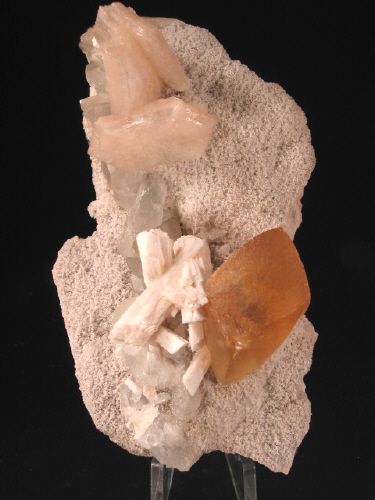 |
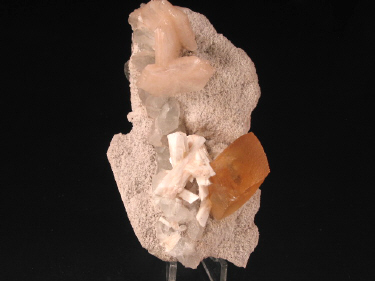 |
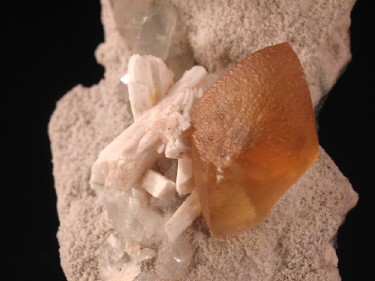 |
|
DV15
Mesolite in Quartz
Nasik
Area, Maharashtra Prov., India
10.1x
5.8x 3.2 cm
$185
A
cabinet specimen hosting an orange (and fairly deeply colored, for
India) calcite crystal that shares its heulandite coated matrix with
stilbite, and apophyllite
There is a bit of cleaving to the
calcite crystal, so the price is somewhat lower.
As
far as India is concerned, I can only recall seeing calcites of this
habit and color from Wagholi (the cavansite locality) though those are
rarely larger than 1 cm.
|
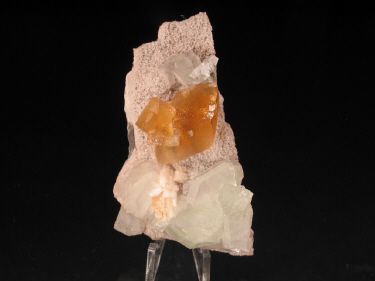 |
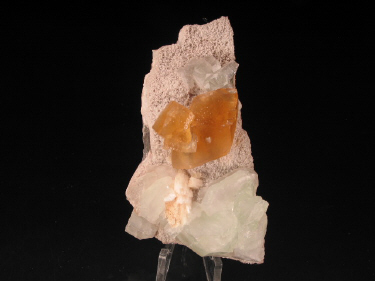 |
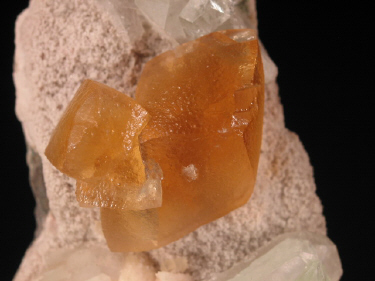 |
|

DV41
Calcite, Quartz
Nasik
Area, Maharashtra Prov., India
10.1x
6.7x 3.8 cm
$165
A
specimen consisting of a double terminated calcite scalenohedron perched
on a quartz stalactite. There is a minor cleave on the end of one
of the calcite's terminations, but you have to look closely to see it,
and the price takes this into account.
|
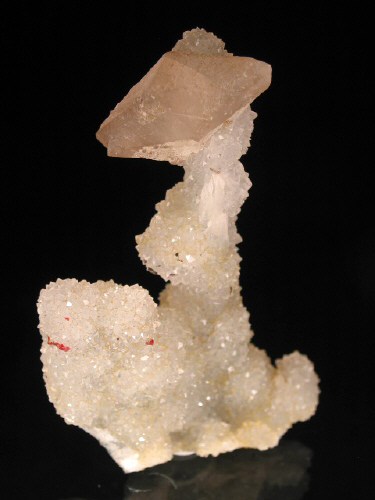 |
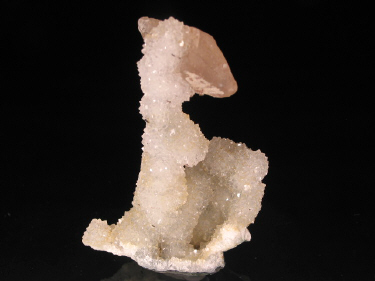 |
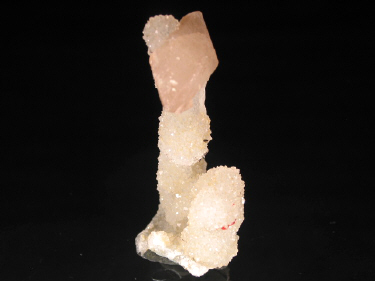 |
|

DV16
Mesolite in Quartz
Aurangabad,
Maharashtra Prov., India
6.2x
5.7x 2.0 cm
$165
An
oddity from India, this is a speicmen consisting of a botryoidal
chalcedony hosting two bright, reddish orange clusters of another
zeollite, possibly mesolite.
I
saw some of these at the Houston show for prices starting about double
mine....
New
and very unusual material, I had not seen anything quite like this prior
to this year.
|
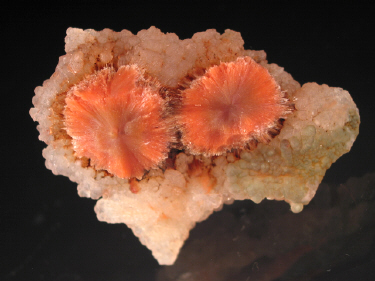 |
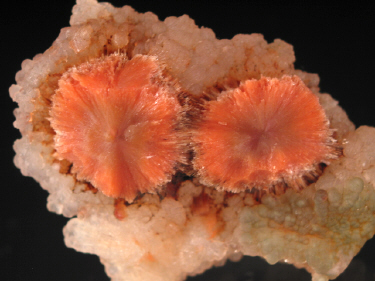 |
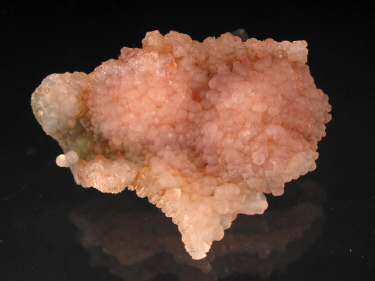 |
|

DV17
Mesolite in Quartz
Aurangabad,
Maharashtra Prov., India
3.5x
3.3x 1.9 cm
$160
An
oddity from India, this is a hemispherical specimen consisting of a
botryoidal chalcedony geode enclosing a bright reddish orange cluster of
another zeollite, possibly mesolite.
I
saw some of these at the Houston show for prices starting about double
mine....
In
any case, this is a beautiful and very unusual "toenail"/
small miniature sized specimen that certainly stands out.
|
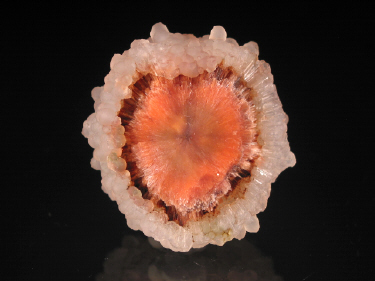 |
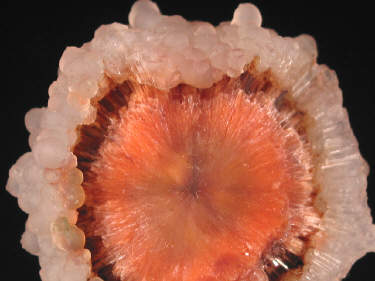 |
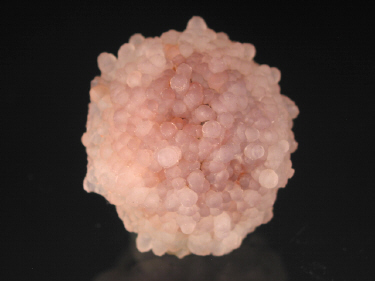 |
|
DV18 Ettringite, Andradite
N'chwanning Mines, Kalahari Mn
Fields., South Africa
4.1x 4.0x 3.5 cm
$350
A bright yellow, terminated crystal
of ettringite on a matrix mostly composed of andradite. These
ettringites are from a find made within the last year and a
half.
The last major find of sizable
prismatic ettringite at this location was in the 1980's. Since then,
there have been numerous crusts, jumbles of small crystals, and
flattened examples that don't really stand out from their
matrixes.
The ettringite crystals from this
find have been quite large by the standards of the species. The
pieces posted here are not the biggest crystals from the find, but even so, they remain
quite sizable for ettringite.
I will also add that I have
priced these significantly lower than what I have seen from the couple
other places offering them
|
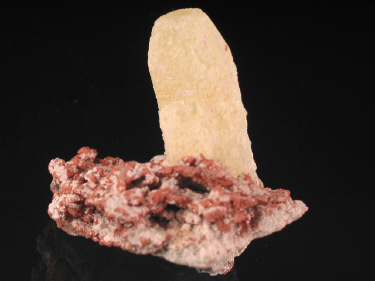 |
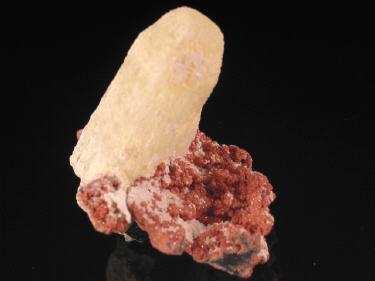 |
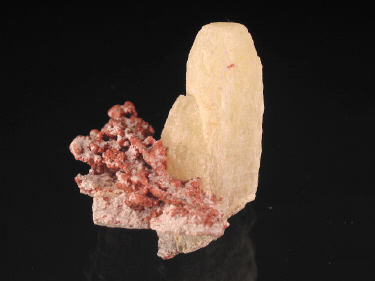 |
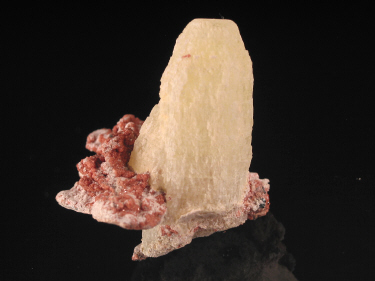 |
|

DV19 Ettringite, Andradite
N'chwanning Mines, Kalahari Mn
Fields., South Africa
5.8x 2.6x 2.2 cm
$250
A bright yellow, terminated crystal
of ettringite on a matrix mostly composed of andradite. These
ettringites are from a find made within the last year and a
half.
The last major find of sizable
prismatic ettringite at this location was in the 1980's; since then
there have been numerous crusts, jumbles of small crystals, and
flattened examples that don't really stand out from their
matrixes.
The ettringite crystals from this
find have been quite large by the standards of the species. The
pieces here are not the biggest crystals from the find, but even so, they remain
quite sizable for ettringite.
I will also add that I have
priced these significantly lower than what I have seen from the couple
other places offering them
|
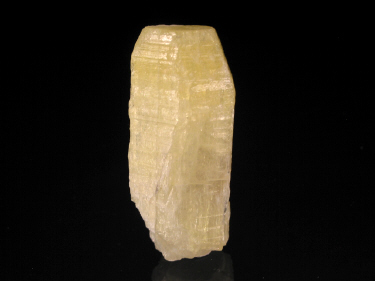 |
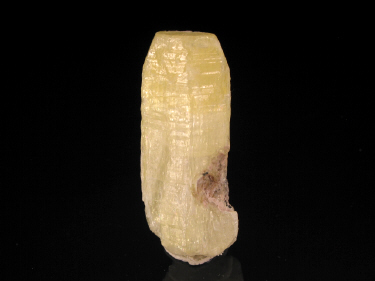 |
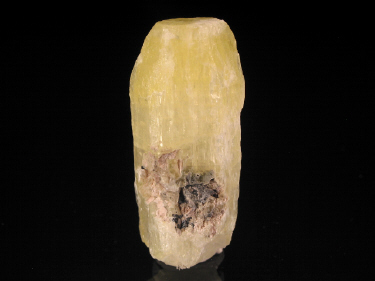 |
|

DV20 Ettringite, Andradite
N'chwanning Mines, Kalahari Mn
Fields., South Africa
4.3x 1.3x 1.2 cm
$200
A bright yellow, terminated crystal
of ettringite on a matrix mostly composed of andradite. These
ettringites are from a find made within the last year and a
half.
The last major find of sizable
prismatic ettringite at this location was in the 1980's; since then
there have been numerous crusts, jumbles of small crystals, and
flattened examples that don't really stand out from their
matrixes.
The ettringite crystals from this
find have been quite large by the standards of the species. The
crystals posted here are not the biggest from the find, but even so, they remain
quite sizable for ettringite.
I will also add that I have
priced these significantly lower than what I have seen from the couple
other places offering them
|
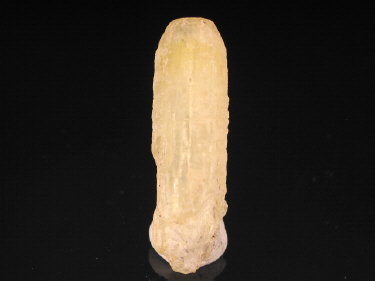 |
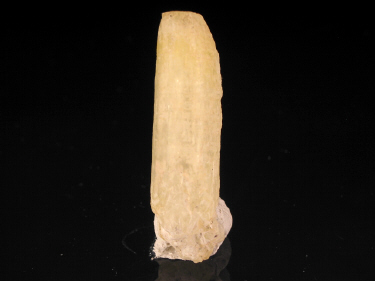 |
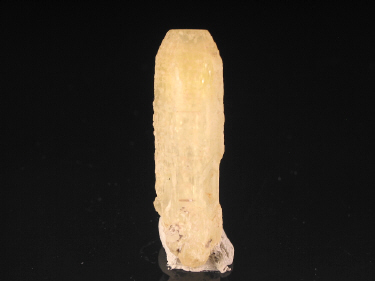 |
|
DV21
"Achtaragdite"
(Hydrogrossular-Chlorite-Carbonate pseudo after Wadalite [?])
Akhtaragda
River mouth, Vilyui River Basin, Saha Republic, Eastern-Siberian Region,
Russia
2.2x
2.1x 1.7 cm
$85
A very unusual pseudomorph, I have
only seen a few of these for sale, usually labeled as "Feldspar ps.
Helvite." According to Mindat they are actually a combination
of minerals after (most likely) a hydrogarnet, though exactly what
species has been replaced is unknown.
In any case, this is a pretty good
example of this rare pseudo... an
interesting mineralogical oddity.
|
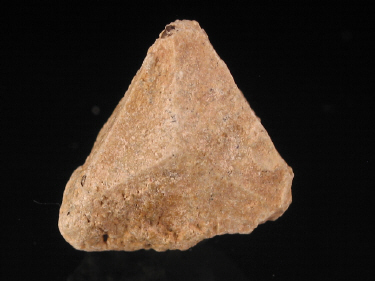 |
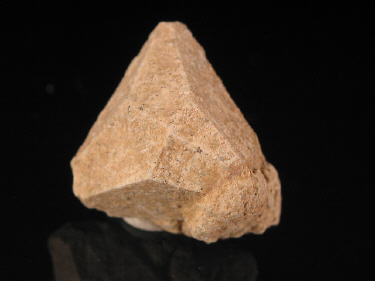 |
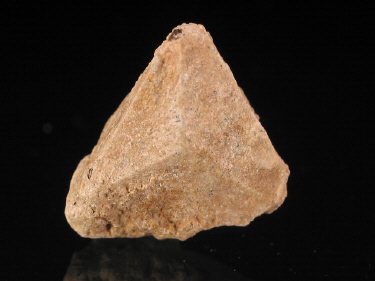 |
|
DV22
"Achtaragdite"
(Hydrogrossular-Chlorite-Carbonate pseudo after Wadalite [?])
Akhtaragda
River mouth, Vilyui River Basin, Saha Republic, Eastern-Siberian Region,
Russia
2.4x
2.2x 2.0 cm
$100
A very unusual pseudomorph, I have
only seen a few of these for sale, usually labeled as "Feldspar ps.
Helvite."
According to Mindat these specimens
are actually a combination of minerals that have replaced what was most
likely a hydrogarnet. Exactly what species the specimen originally
was however, is unknown.
In any case, this is a pretty good
example of this rare pseudo.... an interesting mineralogical oddity.
|
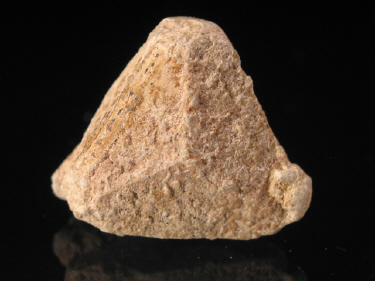 |
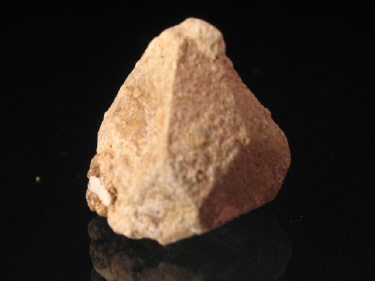 |
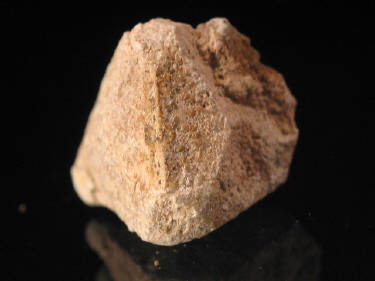 |
|

DV23
Monazite
Olhos
D'Aghua Dist., Bocaiuva, Minas Gerais, Brazil
3.3x
3.1x 2.4 cm
$300
A rather large specimen of V-twinned
monazite crystals from a very small new find in Brazil. I remember a few years ago there
were a number of X-twins from Buenopolis, but those generally much
smaller.
The crystals are exceptionally sharp
for the size, and the
faces well defined. Moreover, some of the faces could
actually be called lustrous, and the specimen is complete all around.
This is an excellent miniature
specimen of this normally unremarkable species.
|
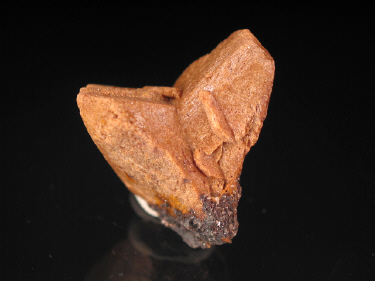 |
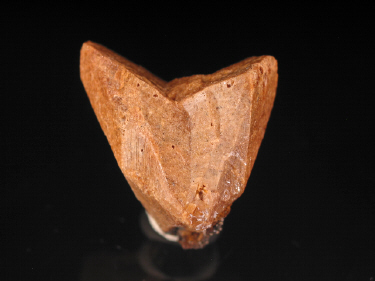 |
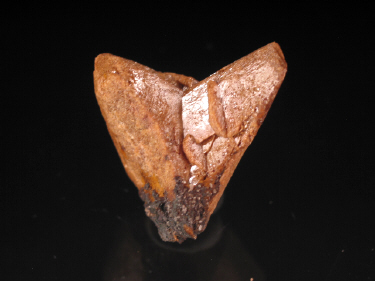 |
|

DV24 Perovskite
Miass,
Ilmen Mts, Chelyabinsk Oblast', Southern Urals, Urals Region, Russia
3.9x
3.9x 2.1 cm
$200
A nice miniature specimen with a
sharp and complete, cubic perovskite crystal on matrix. |
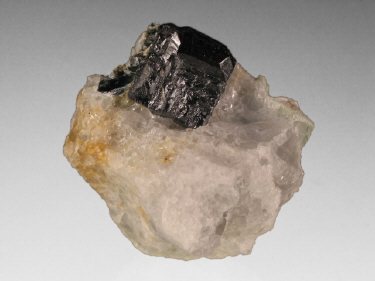 |
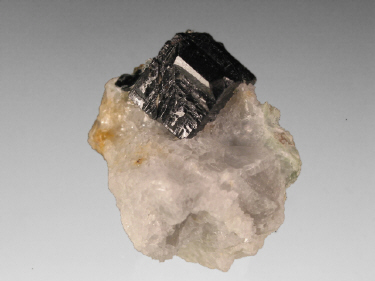 |
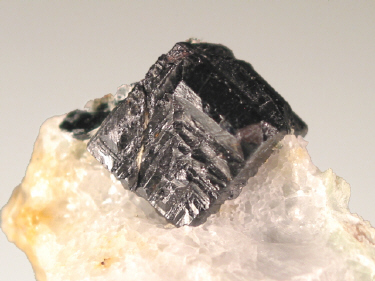 |
|
DV25
Miersite
on Cuprite
Rubtsovskoe
Cu-Zn-Pb deposit, Rudnyi Altai, Altaiskii Krai, Western-Siberian Region,
Russia
4.4x
3.3x 2.8 cm
$430
These cuprites have been around for
the last two years, more or less, but the prices have been very,
very high. I noticed that one dealer had lowered his prices a bit,
so I purchased several specimens.
This specimen would be a very good
cuprite in its own right, except that it is one of very few specimens
that also has the rare silver copper iodide miersite present as a bright
yellow crust on one of the cuprite faces.
Miersite is known from only a few
loactions worldwide, and almost always occurs as microcrystals.
The only decent specimens I know of have come from the Broken Hill
complex in Australia, and now the Rubtsobskoe Mine in
Russia.
The marked price would be good for
just the cuprite alone, but the miersite is an added bonus.
|
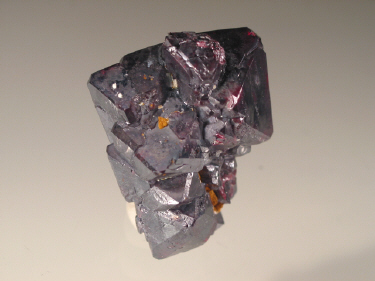 |
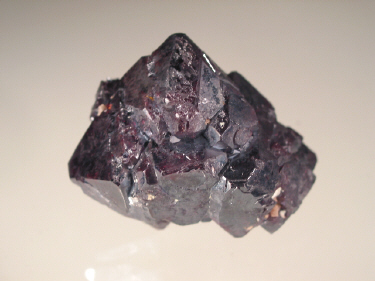 |
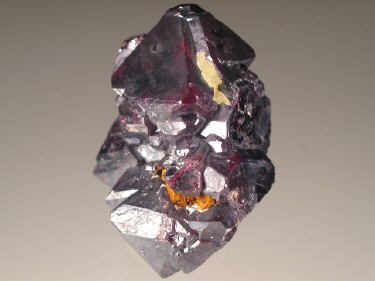 |
|
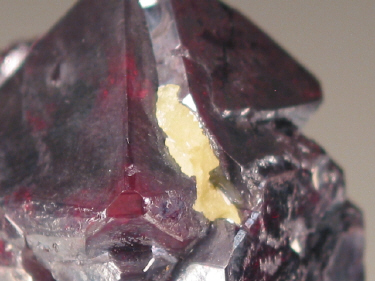
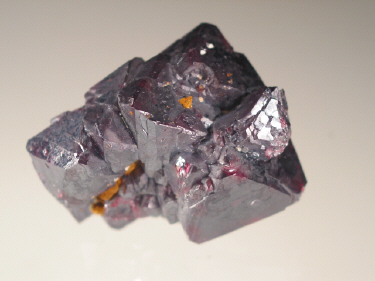
|
|
DV26
Cuprite
Rubtsovskoe
Cu-Zn-Pb deposit, Rudnyi Altai, Altaiskii Krai, Western-Siberian Region,
Russia
6.7x
5.3x 3.4 cm
$300
These cuprites have been around for
the last two years, more or less, but the prices have been very,
very high. I noticed that one dealer had lowered his prices a bit,
so I purchased several specimens
This specimen has a minor silver
association, particularly visible in the lower left hand image.
|
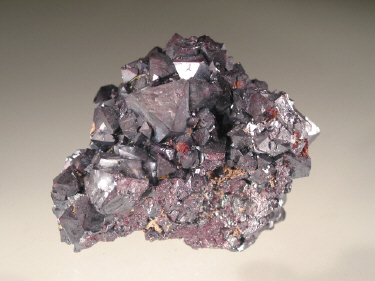 |
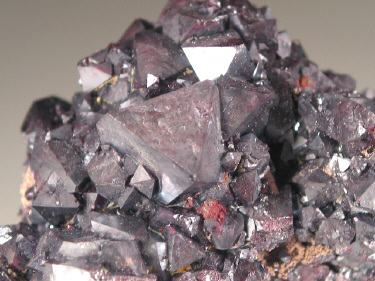 |
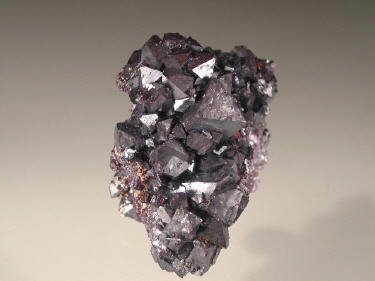 |
|
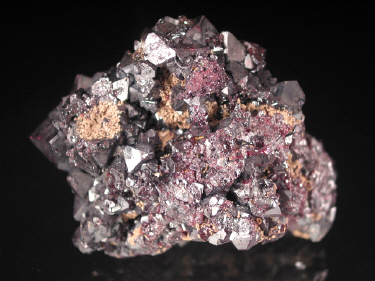 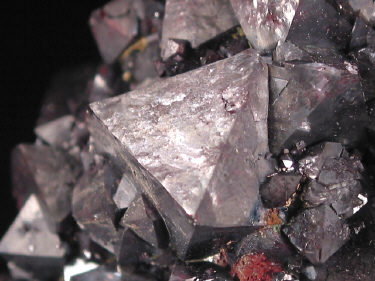
|
|

DV27
Cuprite, Silver
Rubtsovskoe
Cu-Zn-Pb deposit, Rudnyi Altai, Altaiskii Krai, Western-Siberian Region,
Russia
4.0x
2.7x 2.5 cm
$160
These cuprites have been around for
the last two years, more or less, but the prices have been very,
very high. I noticed that one dealer had lowered his prices a bit,
so I purchased several specimens
This specimen has a silver
association, partially visible in the lower right hand image.
There is more of this silver on the bottom.
|
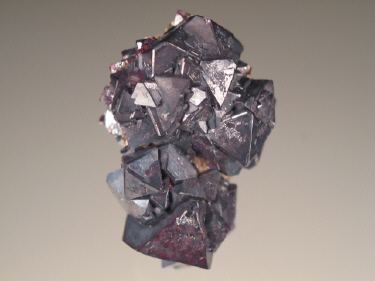 |
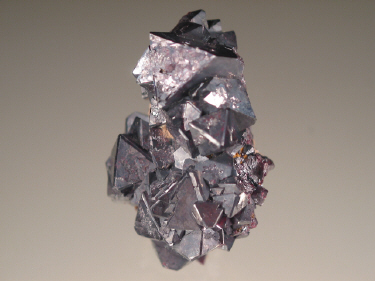 |
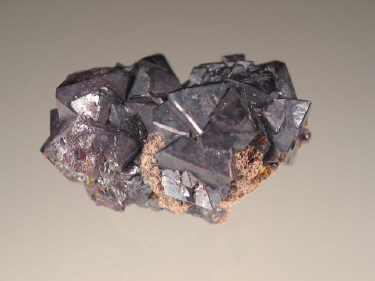 |
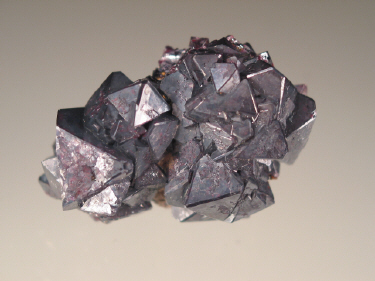 |
|

DV28 Red
Quartz, Calcite, Dolomite Chalcopyrite
Fengjiashan
Mine, Huangshi Pref., Hubei Prov., China
16.0x
12.9x 10.5 cm
$370
A
large cabinet specimen of quartz, stained bright-red by iron oxide
inclusions. Parts of the quartz cluster have been overgrown by
dolomite, chalcopyrite, and there are calcite scalenohedrons interspersed
throughout the matrix.
These
were first debuted about a year ago, and are a beautiful example of red
colored quartz.
|
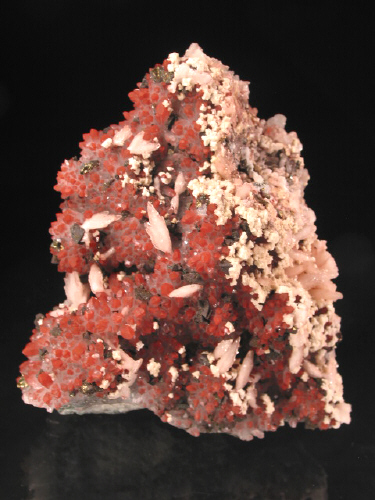 |
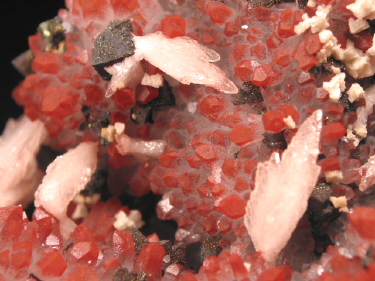 |
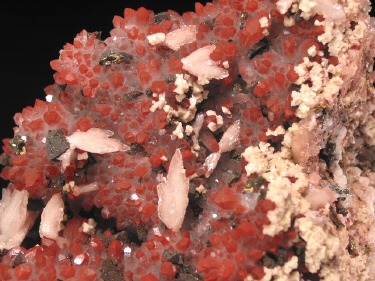 |
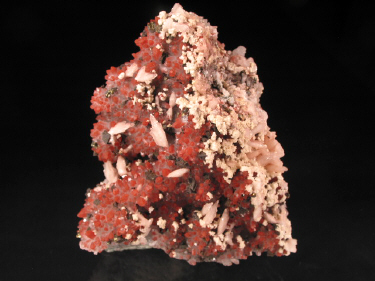 |
|

DV29 Red
Quartz, Calcite, Dolomite Chalcopyrite
Fengjiashan
Mine, Huangshi Pref., Hubei Prov., China
16.2x
13.2x 6.5 cm
$360
A
large cabinet specimen of quartz, stained bright-red by iron oxide
inclusions. Parts of the quartz cluster have been overgrown by
dolomite, chalcopyrite, and there are calcite scalenohedrons interspersed
throughout the matrix.
These
were first debuted about a year ago, and are a beautiful example of red
colored quartz.
|
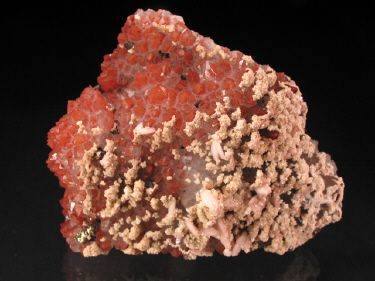 |
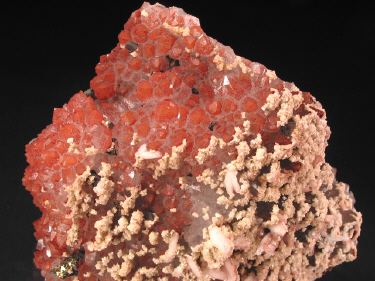 |
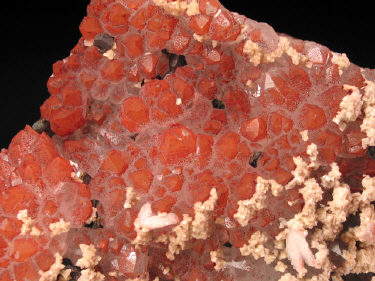 |
|
DV30
Red
Quartz, Calcite, Dolomite Chalcopyrite
Fengjiashan
Mine, Huangshi Pref., Hubei Prov., China
14.5x
12.3x 7.6 cm
$335
A
large cabinet specimen of quartz, stained bright-red by iron oxide
inclusions. Parts of the quartz cluster have been overgrown by
dolomite, and chalcopyrite.
These
were first debuted about a year ago, and are a beautiful example of red
colored quartz.
|
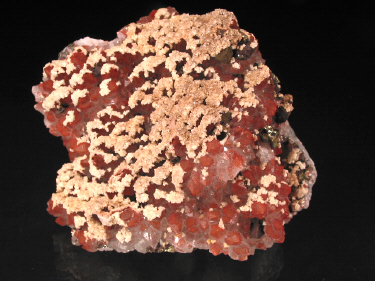 |
 |
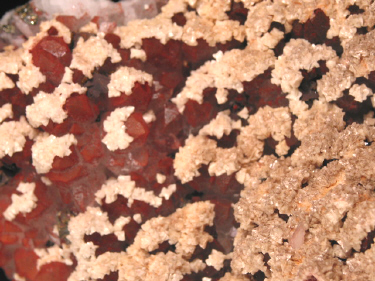 |
|

DV31
Red
Quartz, Calcite, Dolomite Chalcopyrite
Fengjiashan
Mine, Huangshi Pref., Hubei Prov., China
17.2x
13.1x 8.0 cm
$330
A
large cabinet specimen of quartz, stained bright-red by iron oxide
inclusions. On this speicmen, most of the quartz cluster has been overgrown by
calcite scalenohedrons which are also stained red by iron oxide.
These
were first debuted about a year ago, and are a beautiful example of red
colored quartz.
|
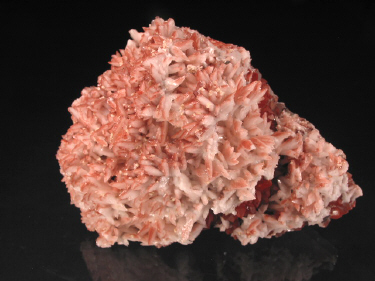 |
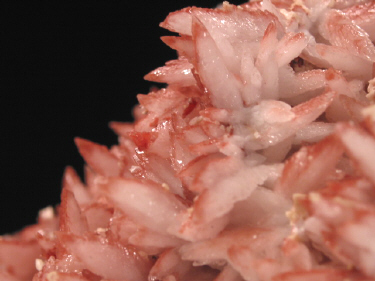 |
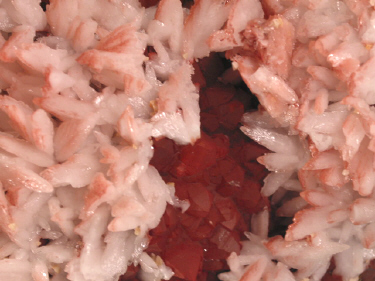 |
|

DV32
Dioptase
Christoff
Mine, Kuene Region, Kaokoveld Plateau, Namibia
3.5x
2.7x 2.2 cm
$165
A
nice minature specimen consisting of a medallion-like cluter of
elongated dioptase crystals. This locality is the latest Namibian
dioptase producer, and it's specimens have some of the largest crystals
found in the country to date: the average crystal size at Tsumeb and
even the early 2000's finds at Kandesi were considerably smaller.
This
is nice miniature specimen from the find, and an example of material
that has not been very widely available.
|
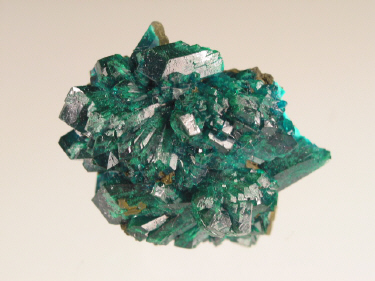 |
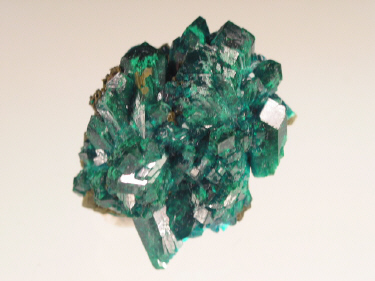 |
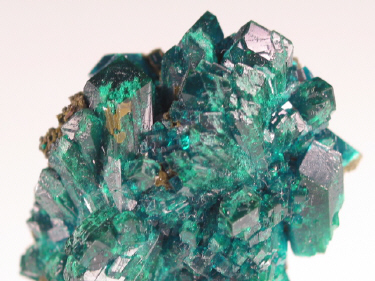 |
|

DV33
Dioptase
Christoff
Mine, Kuene Region, Kaokoveld Plateau, Namibia
3.4x
3.2x 2.4 cm
$165
A
nice minature specimen consisting of a medallion-like cluter of
elongated dioptase crystals. This locality is the latest Namibian
dioptase producer, and it's specimens have some of the largest crystals
found in the country to date: the average crystal size at Tsumeb and
even the early 2000's finds at Kandesi were considerably smaller.
This
is nice miniature specimen from the find, and an example of material
that has not been very widely available.
|
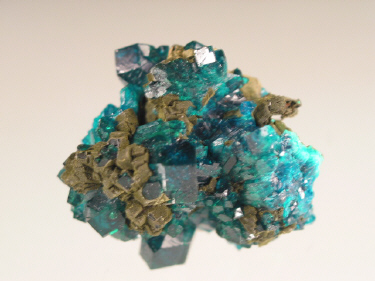 |
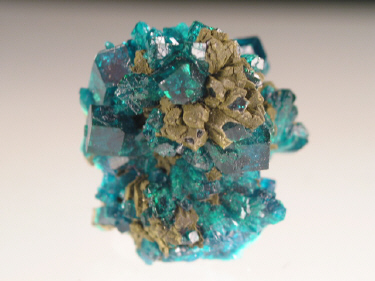 |
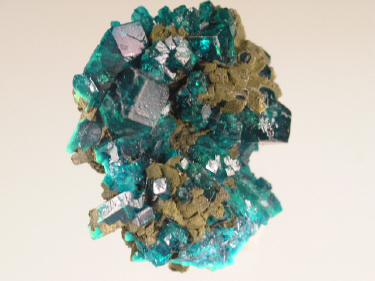 |
DV34 Rhodochrosite
Ushkatyn deposits, Zhayrem, Karagandy Province, Kazakhstan
5.6x 3.4x 1.6 cm
$230
A very unusual rhodochrosite, from a find made in the mid 1990's.
Botryoidal rhodochrosite is known from a few places, particularly a few
long closed localities in Germany and Japan. Where these differ
most however, is in the depth of the red color. More often than
not, botryoidal rhodochrosite tends to be a very light pink. At Ushkatyn,
it is nearly maroon. Actually, I cannot think of another location
that has quite this color of rhodochrosite, be it crystalline or
botryoidal.
This specimen is rather unique because you can actually see the many small crystals that have formed in an almost compressed manner, making the specimen appear botryoidal. On most of these pieces, the individual crystals are indistinguishable.
This interesting material is not often available, and while I don't
expect them to sell particularly quickly, they were just too cool to
pass up.
|
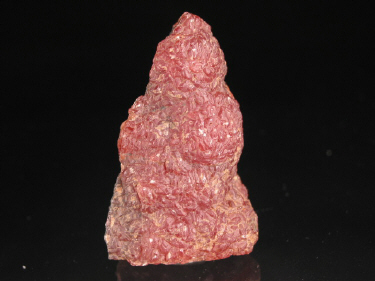 |
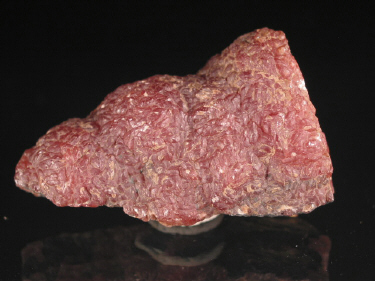 |
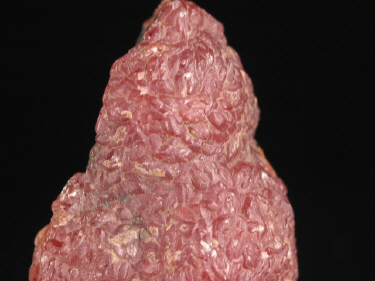 |
|
DV35
Rhodochrosite
Ushkatyn
deposits, Zhayrem, Karagandy Province, Kazakhstan
7.8x
6.5x 2.1 cm
$390
A very unusual
rhodochrosite, from a find made in the mid 1990's. Botryoidal
rhodochrosite is known from a few places, particularly a few long closed
localities in Germany and Japan. Where these differ most however,
is in the depth of the red color. More often than not, botryoidal
rhodochrosite tends to be a very light pink. At Ushkatyn, it is nearly
maroon. Actually, I cannot think of another location that has
quite this color of rhodochrosite, be it crystalline or botryoidal.
One
side of the specimen has been polished to show the concentric banding of
rhodochrosite beneath the surface.
The
piece is probably 90% rhodochrosite, usually rhodo layer s somewhat
thinner.
This
was one of the larger specimens available, and I selected it because it
did not have a shard-like appearance, as is so often the case when a
specimen was originally part of a much larger layer of material.
It also shows the botryoidal habit well, and the rhodochrosite is
particularly thick.
This interesting material is not often available,
and while I don't expect them to sell particularly quickly, they were
just too cool to pass up.
|
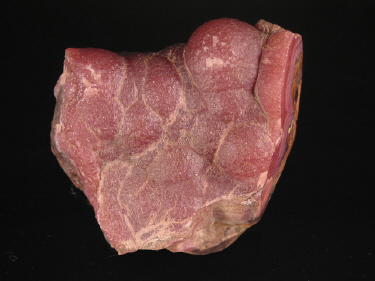 |
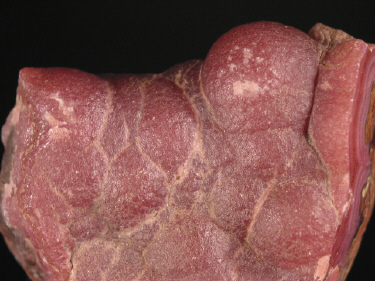 |
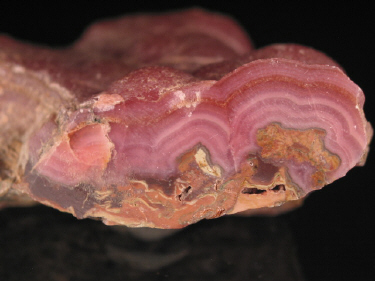 |
DV36 Rhodochrosite
Ushkatyn deposits, Zhayrem, Karagandy Province, Kazakhstan
5.0x 3.9x 2.9 cm
$200
A very unusual rhodochrosite, from a find made in the mid 1990's.
Botryoidal rhodochrosite is known from a few places, particularly a few
long closed localities in Germany and Japan. Where these differ
most however, is in the depth of the red color. More often than
not, botryoidal rhodochrosite tends to be a very light pink. At Ushkatyn,
it is nearly maroon. Actually, I cannot think of another location
that has quite this color of rhodochrosite, be it crystalline or
botryoidal.
This specimen is rather unique because you can actually see the many small crystals that have formed in an almost compressed manner, making the specimen appear
botryoidal. On most of these pieces, the individual crystals are indistinguishable.
This interesting material is not often available, and while I don't
expect them to sell particularly quickly, they were just too cool to
pass up.
|
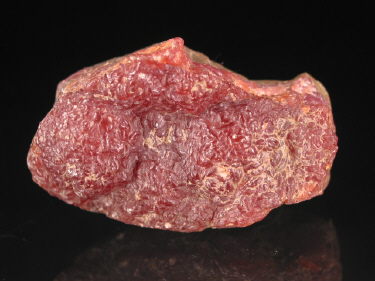 |
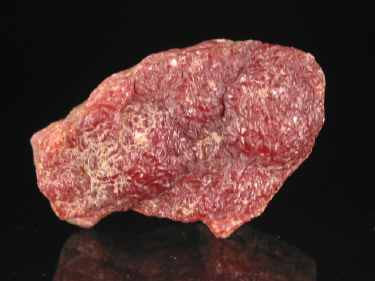 |
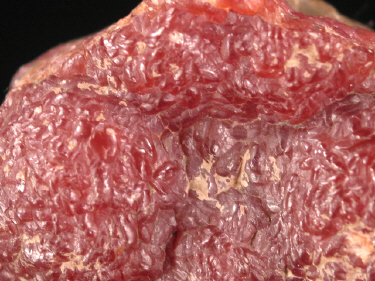 |

DV37 Rhodochrosite
Ushkatyn deposits, Zhayrem, Karagandy Province, Kazakhstan
5.6x 3.4x 1.6 cm
$185
A very unusual rhodochrosite, from a find made in the mid 1990's.
Botryoidal rhodochrosite is known from a few places, particularly a few
long closed localities in Germany and Japan. Where these differ
most however, is in the depth of the red color. More often than
not, botryoidal rhodochrosite tends to be a very light pink. At Ushkatyn,
it is nearly maroon. Actually, I cannot think of another location
that has quite this color of rhodochrosite, be it crystalline or
botryoidal.
This specimen is rather unique because you can actually see the many small crystals that have formed in an almost compressed manner, making the specimen appear
botryoidal. On most of these pieces, the individual crystals are indistinguishable.
This interesting material is not often available, and while I don't
expect them to sell particularly quickly, they were just too cool to
pass up.
|
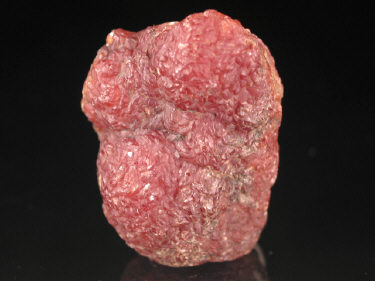 |
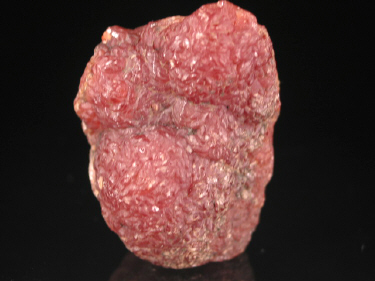 |
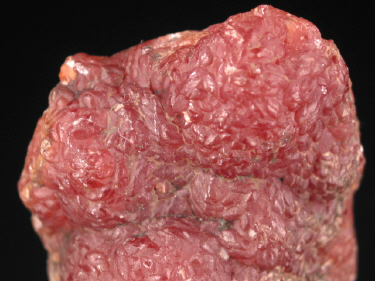 |
|
DV38
RhodochrositeUshkatyn
deposits, Zhayrem, Karagandy Province, Kazakhstan
8.2x
5.3x 2.5 cm
$250
A very unusual
rhodochrosite, from a find made in the mid 1990's. Botryoidal
rhodochrosite is known from a few places, particularly a few long closed
localities in Germany and Japan. Where these differ most however,
is in the depth of the red color. More often than not, botryoidal
rhodochrosite tends to be a very light pink. At Ushkatyn, it is nearly
maroon. Actually, I cannot think of another location that has
quite this color of rhodochrosite, be it crystalline or botryoidal.
There
is some edge wear, but given the condition that these are usually
in, this one is in pretty good shape. The the Russians tended to
treat this stuff as lapidary material, so specimens would get thrown
together, and often times destroyed. That is how these specimens
were kept, and i searched to find the examples that were best suitable
for specimens.
This
piece survived pretty well, displaying the botryoidal form and a nice
pearly luster.
This interesting material is not often available,
and while I don't expect them to sell particularly quickly, they were
just too cool to pass up.
|
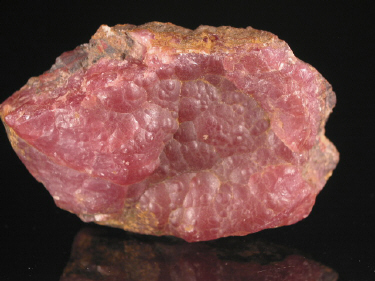 |
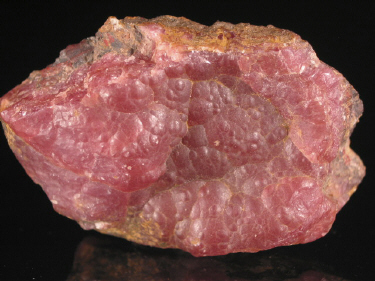 |
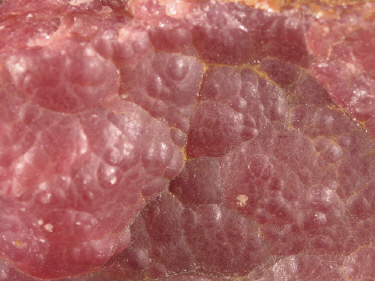 |
|
DV39
Rhodochrosite
Ushkatyn
deposits, Zhayrem, Karagandy Province, Kazakhstan
6.8x
7.5x 2.3 cm
$300
A very unusual
rhodochrosite, from a find made in the mid 1990's. Botryoidal
rhodochrosite is known from a few places, particularly a few long closed
localities in Germany and Japan. Where these differ most however,
is in the depth of the red color. More often than not, botryoidal
rhodochrosite tends to be a very light pink. At Ushkatyn, it is nearly
maroon. Actually, I cannot think of another location that has
quite this color of rhodochrosite, be it crystalline or botryoidal.
This
is one of the larger specimens I obtained, and this material is not
often available these days.
|
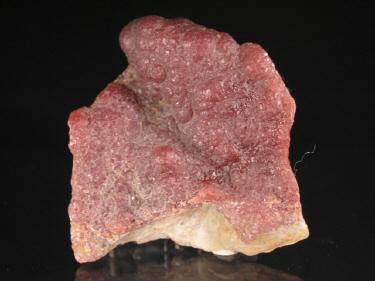 |
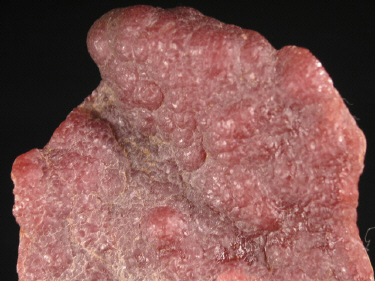 |
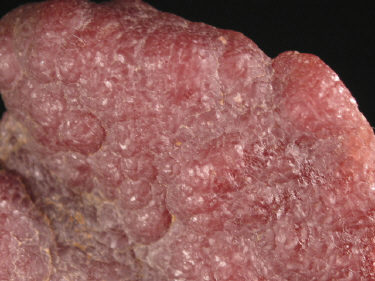 |
DV40
Rhodochrosite
Ushkatyn
deposits, Zhayrem, Karagandy Province, Kazakhstan
6.1x
4.3x 2.1 cm
$200
A very unusual
rhodochrosite, from a find made in the mid 1990's. Botryoidal
rhodochrosite is known from a few places, particularly a few long closed
localities in Germany and Japan. Where these differ most however,
is in the depth of the red color. More often than not, botryoidal
rhodochrosite tends to be a very light pink. At Ushkatyn, it is nearly
maroon. Actually, I cannot think of another location that has
quite this color of rhodochrosite, be it crystalline or botryoidal.
There
is some edge wear, but given the condition that these are usually
in, this one is in pretty good shape. The the Russians tended to
treat this stuff as lapidary material, so specimens would get thrown
together, and often times destroyed. That is how these specimens
were kept, and i searched to find the examples that were best suitable
for specimens.
This
piece clearly displays the botryoidal form and a nice pearly luster
|
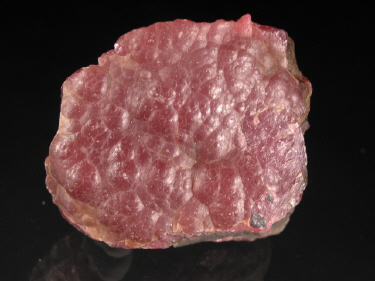 |
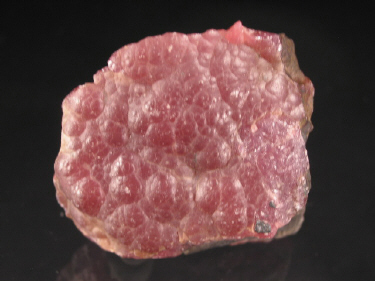 |
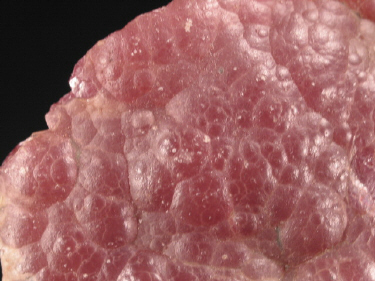 |
Click
here to see the previous update!
|